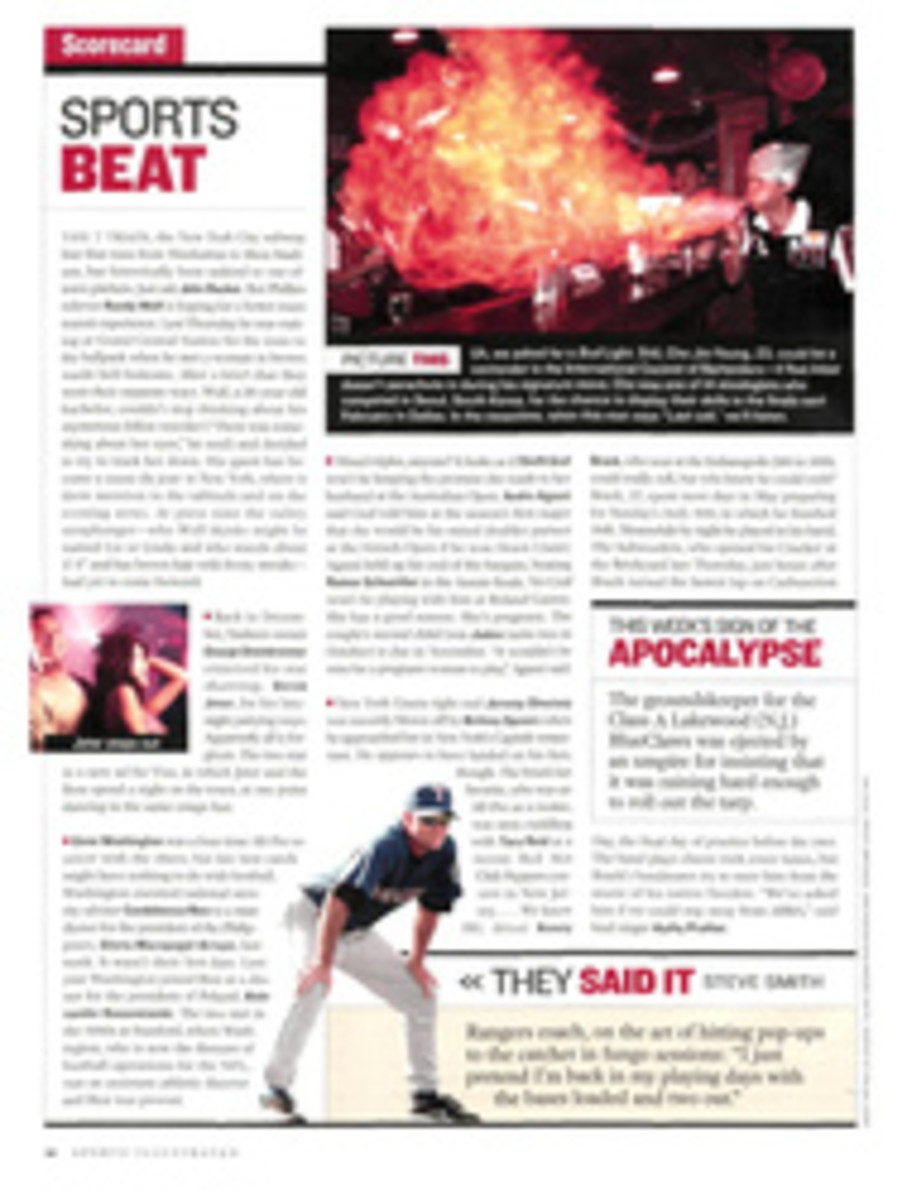
Her Best Shot
For two days a woman golfer played an ordinary PGA Tour event and
turned it into something major. She played with the men, from
their tees, for their money, and everywhere you went, people were
talking about it, including in the men's locker room of the
Colonial Country Club in Fort Worth, Texas, where a PGA Tour
event has been played since 1946, when the Tour was more bawdy
and guys drank well into the night. ¶ As Annika Sorenstam, fit
and muscular and erect, came off the 18th green last Friday, her
eyes were blurry from tears and exhaustion. She had shot an
assembly-line 71 in Thursday's opening round of the Bank of
America Colonial, an exhibition of control and precision on the
fabled par-70 course. She had just holed a 14-footer for par on
Friday for a loose 74 that would have been worse in the hands of
a golfer less composed and not as tough. Golf undresses a
man--that's what they used to say.
Five over par for two rounds, with scores of cameras, hundreds of
reporters, thousands of spectators and millions of television
viewers watching her every shot and fist pump. The 32-year-old
Swedish golfer, winner of 43 LPGA events since 1995, beat some of
the boys, but too few to make the 36-hole cut, which she missed
by four shots. In the plush men's locker room a small group of
players watched her finish on a gigantic TV. "Give her five more
tournaments, she could make a cut," said Esteban Toledo, a
Mexican golfer who came up on the game's dirt paths.
In the weeks leading to the tournament Sorenstam kept saying she
was playing in the Colonial for herself, to test her game on a
big-time course and against a big-time field. She played against
Phil Mickelson, Sergio Garcia, Nick Price and 107 other male
golfers, 11 of whom she ended up beating.
It turned out to be much more than a solo test flight. After two
days and 36 holes and 145 shots, she threw her game ball to a
random fan in the stands, who jumped up and down jubilantly with
it. He had Annika Sorenstam's golf ball! She had done something
over two rounds that she had not accomplished in more than nine
years on the LPGA tour: She had played her way into our
imaginations. The support from her massive galleries was
heartfelt, and in the fading light of a muggy Friday afternoon
Sorenstam had figured out why. "Because I'm living the dream I
want to live," she said, choking on her words. "I'm doing what I
want to do." She was thinking about the possible and got us
thinking that way too.
There were many people, and for a day Vijay Singh was their
courageous, pig-headed and lonely spokesman, who didn't believe a
woman should be invited to play in a PGA Tour event, even though
the tournament sponsor had 12 exemptions to dole out and even
though the Tour has no gender constraints in its bylaws.
Sorenstam ignored the doubters and kept plugging along.
Throughout her career Sorenstam has been a plugger, a model
technician. On Thursday she was that and she was more. She began
her round, on the par-4, 404-yard 10th hole, with a queasy
stomach and wobbly knees and perspiring hands and a textbook par.
She unleashed a 243-yard four-wood, hit a piercing 139-yard
nine-iron, rolled her 16-foot birdie putt smoothly and tapped in.
It wasn't enough. By the end of the day the field would average
3.938 on that hole. She made a perfect par, and it set her back.
Golf's brutal.
But more than she ever had before, Sorenstam exposed her
personality to the public. She did a mock stumble after that
opening tee shot, not as an actress--there is nothing theatrical
in her or her golf game--but to express what she was feeling. The
moment was big, bigger than her and bigger than she had expected.
She was the first woman to play a PGA Tour event since Babe
Didrikson Zaharias competed in the Tucson Open in 1945. Martha
Burk's protest at Augusta in April, that was a media circus. This
was not. This was an athlete pushing herself, in a packed arena
she had never performed in before.
Her playing partners, Aaron Barber and Dean Wilson, are warm
human beings. (Barber was also playing on a sponsor's exemption.)
They say on Tour that every shot, good or bad, makes somebody
happy, but in the Sorenstam-Barber-Wilson group, that wasn't
true. "Remember," Barber said to Wilson before they began play,
"we're in this together." He and Wilson were the anti-Singhs.
They high-fived Sorenstam when she hit good shots, suffered with
her when she hit poor ones and hugged her when it was over.
The Thursday round was played in a dream state. The spectators
following Sorenstam were mostly older folks, golfers, still and
silent when the marshals signaled for quiet. As Sorenstam
prepared to drive on the 9th tee--the last hole of her Thursday
round--a little breeze brought a flurry of white fluffy
cottonwood seeds. She was even par for the day just then and hit
another pure tee shot. She followed it with a sweet-spot
seven-iron that pitched near the hole and trickled over the
green. Then she putted when she needed to chip. With a tuft of
grass behind the ball, any PGA Tour player would have tried to
get the ball in the air rather than rolling it. But Sorenstam,
unsure of her nerves and her ability, chose the most cautious of
shots and ran it eight feet past the hole. She missed the ensuing
putt and made a bogey.
Still, it was a mesmerizing round. A demanding course was playing
easy--the fairways and greens were holding--and Annika Sorenstam
was in control of her game and her emotions. (She hit 13 of 14
fairways and 14 of 18 greens in regulation.) "I'll never forget
the amount of people and how positive they were," she said after
the round. "I'll never forget this day."
Her Friday round was different from the start. Play was sluggish,
the day was hot, her swing looked somehow incomplete. Her gallery
had almost doubled overnight, the Thursday folks returning, plus
schoolchildren and their mothers, and businessmen clenching
cigars and cups of beer. Sorenstam made a birdie on the 2nd hole
to go even par for the tournament and was in position to make the
cut. But then fatigue seemingly set in. Sorenstam later disputed
that, but her caddie, Terry McNamara, and her playing partners
and her shots disagreed. She pushed a few tee shots, hit a couple
of tentative chips and pitches, and in one eight-hole stretch, 5
through 12, made five bogeys. There are no birdie holes at
Colonial, not when you can't smash it off the tee at will, and
hit towering approach shots that curve and spin on command, and
hole all manner of putts. That is not Sorenstam's game, nor any
woman's. That game is indigenous to the elite male professional,
at least for now.
In the meantime Sorenstam has a new list of things to improve.
Her short putting and chipping are below average for a
world-class woman player and poor by the standards of the PGA
Tour. The myth is that the top women chip and putt as well as the
top men. They don't. The modern putting and chipping game is
about controlling the big muscles and taking the hands out of the
swing, and the men, with greater physical strength, do that
better than the women.
Much was said last week about driving distance. Sorenstam, who
has made herself one of the longest hitters in the LPGA, averaged
268 yards off the tee at Colonial; the field averaged 279. There
are men who play the PGA Tour successfully hitting about the
distance Sorenstam does--Loren Roberts, most notably. But they
are wizards on the green and around it. Sorenstam is not, and her
tour has never demanded that she become one.
She won't be returning to the PGA Tour. "I'm a long way from the
leader board," she said after Friday's round. She plays
tournaments to win, not to maybe make a cut. But she's a more
complete golfer now than she was a week ago, for she played two
rounds under a scrutiny more intense, you could argue, than any
other golfer has ever faced, and she survived. In fact, she
thrived. She came in strong and left stronger. The galleries will
side with her from this day forward because at Colonial she dared
to try something bold, did it gracefully and well and let
millions of strangers in on the experience.
As Sorenstam walked up to the 18th green on Friday, the
spectators were applauding her, and she was applauding them.
Frank Lickliter II, a meat-and-potatoes Tour pro, watched for a
moment on a clubhouse TV and said, coldly, "Just go home."
Later that night she did go home, but for only one reason: Her
score was four strokes too high. She wasn't trying to prove
anything to Lickliter last week. She was taking inventory of her
game. She was pushing herself. Along the way, she opened the eyes
of those willing to see.

